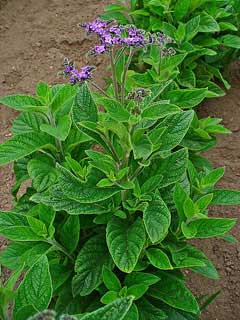 |
|
http://commons.wikimedia.org/wiki/User:Llez |
 |
| http://commons.wikimedia.org/wiki/User:Llez |
Translate this page:
Summary
Bloom Color: Blue, Lavender, Purple, White. Main Bloom Time: Early summer, Early spring, Late summer, Late spring, Late winter, Mid summer, Mid spring, Mid winter. Form: Upright or erect.
Physical Characteristics

 Heliotropium arborescens is an evergreen Shrub growing to 1 m (3ft 3in) by 1 m (3ft 3in) at a medium rate.
Heliotropium arborescens is an evergreen Shrub growing to 1 m (3ft 3in) by 1 m (3ft 3in) at a medium rate.
See above for USDA hardiness. It is hardy to UK zone 10 and is frost tender. It is in leaf all year, in flower from May to September. The species is hermaphrodite (has both male and female organs) and is pollinated by Bees, Lepidoptera (Moths & Butterflies).
It is noted for attracting wildlife.
Suitable for: light (sandy), medium (loamy) and heavy (clay) soils and prefers well-drained soil. Suitable pH: mildly acid, neutral and basic (mildly alkaline) soils. It cannot grow in the shade. It prefers moist soil.
UK Hardiness Map
US Hardiness Map
Synonyms
H. peruvianum. L.
Plant Habitats
Woodland Garden Sunny Edge; South Wall. By. West Wall. By.
Edible Uses
References More on Edible Uses
Medicinal Uses
Plants For A Future can not take any responsibility for any adverse effects from the use of plants. Always seek advice from a professional before using a plant medicinally.
Febrifuge Homeopathy
The plant is used to make a febrifugal tea[200]. A homeopathic remedy is made from the whole fresh plant[4]. It is used in the treatment of clergyman's sore throat and uterine displacement[4].
References More on Medicinal Uses
The Bookshop: Edible Plant Books
Our Latest books on Perennial Plants For Food Forests and Permaculture Gardens in paperback or digital formats.

Edible Tropical Plants
Food Forest Plants for Hotter Conditions: 250+ Plants For Tropical Food Forests & Permaculture Gardens.
More

Edible Temperate Plants
Plants for Your Food Forest: 500 Plants for Temperate Food Forests & Permaculture Gardens.
More

More Books
PFAF have eight books available in paperback and digital formats. Browse the shop for more information.
Shop Now
Other Uses
Essential
An essential oil obtained from the flowers is used in perfumery[57, 171]. The plant is sometimes used as a low hedge, though it is not hardy enough in Britain for this purpose[245].
Special Uses
Attracts Wildlife Scented Plants
References More on Other Uses
Cultivation details
Landscape Uses:Border, Container. Prefers a rich well-drained soil in full sun[200]. Plants grow best in a sandy loam[260]. Severely damaged by low temperatures[1], this plant is not hardy in Britain but it can be grown as a half-hardy annual, flowering in its first year from seed[1, 200]. If grown as a shrub, it requires a minimum winter temperature of 5 - 7°c[200]. Plants stop growing when night-time temperatures fall below 5°c and are likely to be killed once the temperature falls below -2°c[260]. The plant turns its leaves and flowers so that it is always facing the sun during the day[4]. The flowers have a most unusual perfume, somewhat like cherries baked in a pie[245]. It is a good butterfly plant[24, 30]. A parent of the cultivated ornamental garden heliotropes[1], there are many named varieties[200]. Special Features:Not North American native, Attracts butterflies, Fragrant flowers.
References Carbon Farming Information and Carbon Sequestration Information
Temperature Converter
Type a value in the Celsius field to convert the value to Fahrenheit:
Fahrenheit:
The PFAF Bookshop
Plants For A Future have a number of books available in paperback and digital form. Book titles include Edible Plants, Edible Perennials, Edible Trees,Edible Shrubs, Woodland Gardening, and Temperate Food Forest Plants. Our new book is Food Forest Plants For Hotter Conditions (Tropical and Sub-Tropical).
Shop Now
Plant Propagation
Seed - sow early spring in a greenhouse and only just cover the seed. Germination usually takes place within 2 - 25 days at 20°c. When they are large enough to handle, prick the seedlings out into individual pots and plant them out after the last expected frosts. Cuttings of half-ripe wood, 5 - 7cm with a heel, July/August in a frame[78]. High percentage. Because the plant is not hardy the cuttings would have to be grown in a greenhouse for the winter before planting them out in the spring. Cuttings of young shoots in the spring[1]. Because the plant is not hardy the cuttings would have to be grown in a greenhouse for the winter before planting them out in the spring.
Other Names
If available other names are mentioned here
Native Range
SOUTHERN AMERICA: Peru
Weed Potential
Right plant wrong place. We are currently updating this section.
Please note that a plant may be invasive in one area but may not in your area so it's worth checking.
Conservation Status
IUCN Red List of Threatened Plants Status :

Growth: S = slow M = medium F = fast. Soil: L = light (sandy) M = medium H = heavy (clay). pH: A = acid N = neutral B = basic (alkaline). Shade: F = full shade S = semi-shade N = no shade. Moisture: D = dry M = Moist We = wet Wa = water.
Now available:
Food Forest Plants for Mediterranean Conditions
350+ Perennial Plants For Mediterranean and Drier Food Forests and Permaculture Gardens.
[Paperback and eBook]
This is the third in Plants For A Future's series of plant guides for food forests tailored to
specific climate zones. Following volumes on temperate and tropical ecosystems, this book focuses
on species suited to Mediterranean conditions—regions with hot, dry summers and cool, wet winters,
often facing the added challenge of climate change.
Read More
Expert comment
Author
L.
Botanical References
200
Links / References
For a list of references used on this page please go here
Readers comment
© 2010, Plants For A Future. Plants For A Future is a charitable company limited by guarantee, registered in England and Wales. Charity No. 1057719, Company No. 3204567.